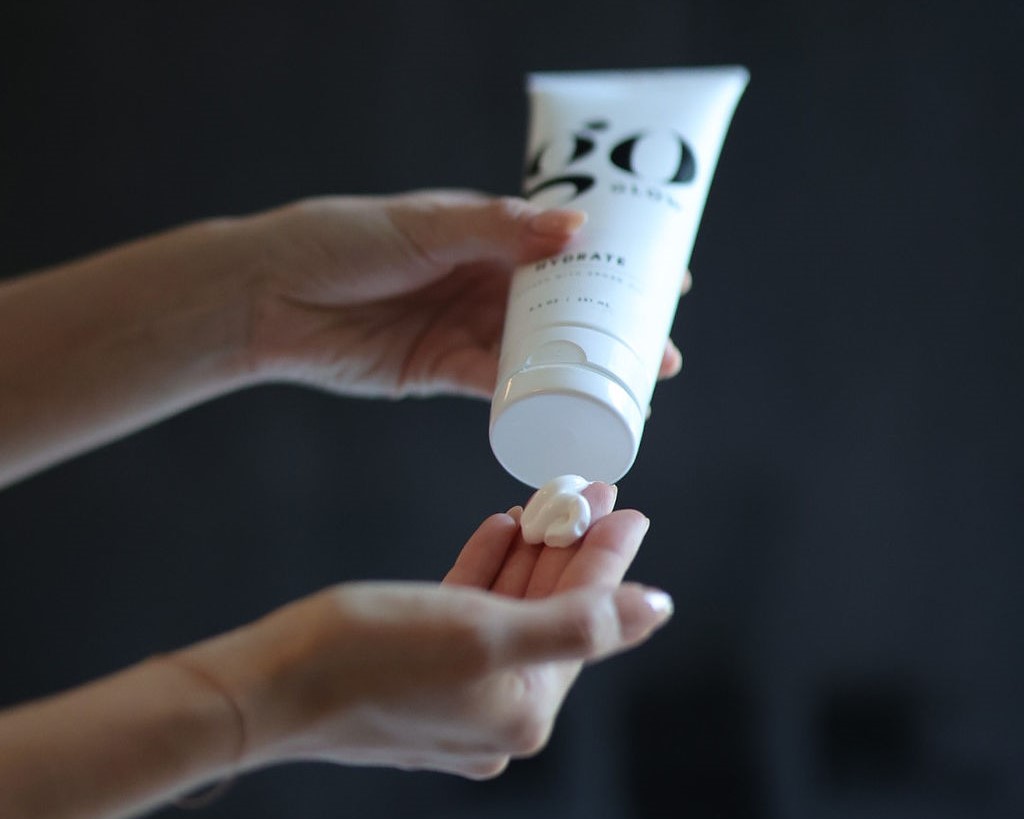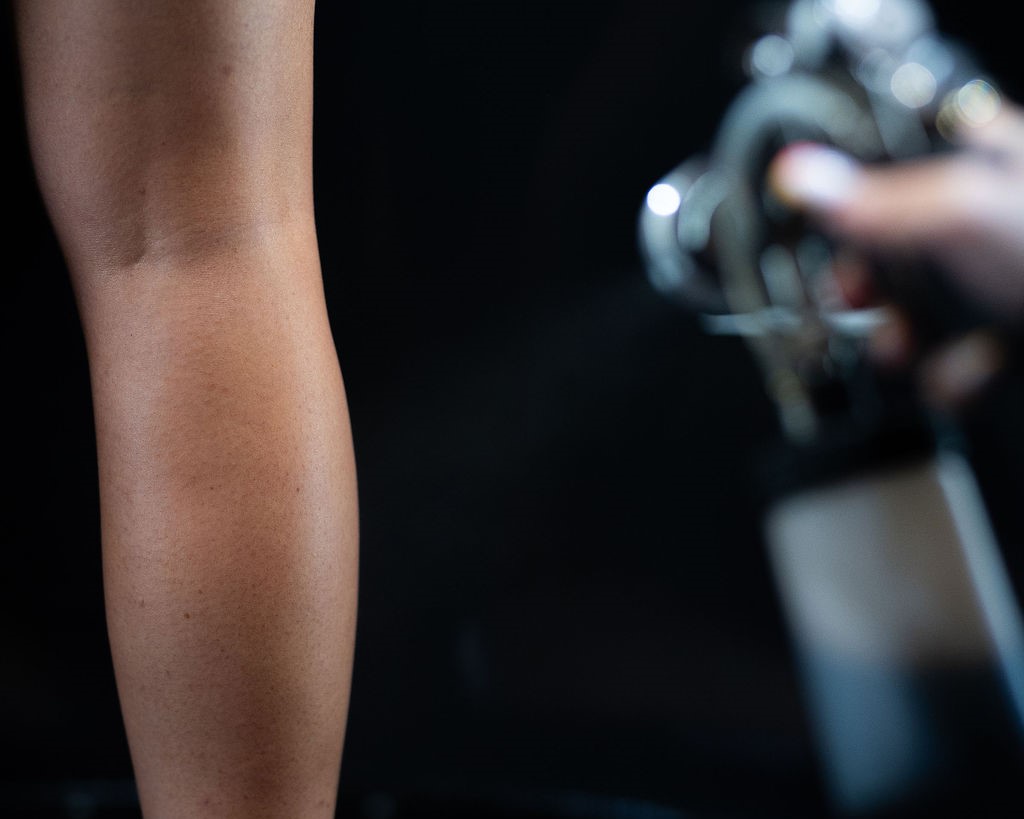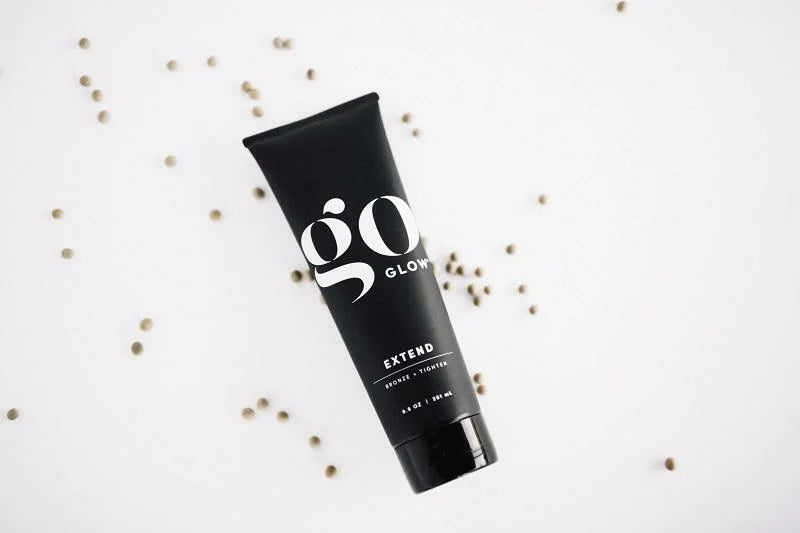Spray or sunless tanning offers a convenient and sun-safe way to achieve a golden glow without the harmful effects of UV exposure, either naturally or from tanning beds.
However, not all skin types or conditions react the same to sunless tanners, and taking some time to learn exactly how will increase your chances of avoiding a bad spray tanning experience in your next session.
Let’s explore how spray tans interact with skin conditions, recent skin treatments, and cosmetics, offering realistic and reliable solutions for a flawless glow while keeping your skin healthy.
The Chemistry of Spray Tans: What Makes You Glow?
Spray tans work by utilizing a key ingredient, dihydroxyacetone (DHA), which interacts with the outer layer of the skin to produce a temporary glowing look.
If you or someone you know has had a skin condition or treatment that puts a future body spray appointment in doubt, knowing the science behind this process can help anticipate how different skin types and conditions might react, ensuring a smooth and worry-free tanning treatment.
What Happens When You Spray Tan?
Spray tans work through the topical application of a sunless tanning product containing DHA (dihydroxyacetone), the active ingredient in spray tans.
DHA reacts with amino acids in the outermost layer of the skin (comprised of dead skin cells), triggering a Maillard reaction that leads to the appearance of a darker color or tan.
Unlike the color (and the DNA damage that comes along) you get from sun exposure, this chemical reaction only affects the outer layer and does not penetrate into deeper skin layers or pose any danger to your skin in any way.
Why Skin Health Matters in Spray Tanning
What is more common are uneven applications or results based on certain conditions or circumstances. Skin type, hydration levels, and underlying health conditions can significantly influence how a tanning solution develops. For example, dry skin or coarser skin on areas like elbows and knees can lead to patchy results.
Similarly, sensitive skin may experience skin irritation or allergic reactions from harsh ingredients found in poor-quality or non-natural products, which is something you will never be exposed to at goGLOW.
A key to preventing undesired results or reactions on your way to glowing skin is: Exfoliation.
We recommend exfoliating 24-48 hours before your appointment with a tool (dry brush, exfoliating mitt), not a scrub. Scrubs are typically petroleum-based and create a barrier on the skin that can leave you looking patchy or splotchy.
Our goGLOW EXFOLIATE Mitt is a fan favorite for getting off all of the dead skin in preparation for a goGLOW appointment.
Common Skin Conditions & Their Interaction with Spray Tans
Here’s a look at some common skin conditions and how they might interact with spray tans.
Eczema & Psoriasis
Both of these conditions can cause thickened, scaly patches that resist even application, while flare-ups may react adversely to DHA or other ingredients in spray tan solutions, like fragrances or some added colors.
- Solution: People with eczema or psoriasis should consult a doctor for skin conditions, use fragrance-free custom mixtures if available, and patch test every sunless tanning product first before applying it to the entire body. We can also offer a barrier cream to the area so it doesn’t grab the color.
Acne & Rosacea
Inflamed skin may absorb tanner unevenly, leading to brown marks or a bad spray tanning experience. Harsh ingredients may worsen flare-ups, although for patients with rosacea, DHA might actually improve their coloration as it evens out the appearance of the condition’s red splotches.
- Solution: Exfoliate effectively before your session and look for tanning products labeled as non-comedogenic (they don’t clog pores). Opt for gentle, natural products, like those based on coconut oil, and always do a patch test first.
Skin Cancer or Post-Treatment Skin
Any form of skin cancer or recent dermatological treatment may make the skin sensitive to chemical reactions from tanning skin.
- Solution: A medical professional must approve any tanning treatment. Avoid all-over sprays on affected areas until you get the go-ahead from your physician.
Allergies or Contact Dermatitis
Reactions like allergic contact dermatitis or contact dermatitis may arise from preservatives or fragrances in some sunless tanners.
- Solution: Use hypoallergenic and avoid common tanning methods that involve an abnormal amount of chemical exposure. Anyone with sensitive skin should always ask for a patch test to see how their skin reacts before deciding to their entire body.
Vitiligo
Uneven melanin distribution leads to patchy tanning with self-tanning products.
- Solution: Seek a skilled tanning expert like those at goGLOW for a custom approach or body contouring approach using bronzers that blend lighter and darker areas.
Oily Skin
Oily skin slows DHA absorption, increases the risk of bad application, and causes streaks.
- Solution: Exfoliate using lukewarm showers and sulphate-free soap before your tanning session. Use a lightweight, quick-dry sunless tanner when self-applying.
Sunburn or Peeling Skin
Applying a sunless tanning product over damaged to cell DNA skin can worsen irritation and white marks, and lead to poor application results.
- Solution: Wait until healing is complete (4-6 weeks), exfoliate gently to remove dead cells, and avoid continual tanning. Always use soothing, natural products, like HYDRATE, which encourages healing.

Cosmetic Products That Interfere with Spray Tans
When aiming for a flawless sunless tan, it’s crucial to be cautious about the cosmetic products you use alongside your spray tan. Some skincare and beauty products can interfere with the absorption and longevity of the tan, leading to unsatisfactory results.
Here’s what to watch out for to ensure your spray tan stays intact and beautiful.
Makeup, Primers, and Moisturizers
These products create barriers that block the tanning solution from reaching the outermost layer of the skin, resulting in a light layer or poor application.
- Solution: Clean the skin thoroughly before your spray tan appointment. Use oil-free, non-comedogenic skincare before tanning.
Deodorants and Perfumes
Ingredients in these products may interact chemically with DHA, leading to discoloration.
- Solution: Avoid using these products on the day of tanning. And don’t forget to bring cotton sweats or loose-fitting clothing to avoid rubbing the tanner.
Exfoliants, Retinoids, and AHAs
Products like alpha-hydroxy acid and retinoids remove dead skin cells aggressively, which may lead to uneven color or flaky patches post-tan.
- Solution: Cease use at least 3-5 days before before a tanning treatment. Switch to gentler exfoliants or to the goGLOW EXFOLIATE Mitt, which uses only warm water to gently exfoliate and get a professional result perfect for your next tanning session. You can also rely on the goGLOW CLEANSE for daily use, which is based on the softer and natural hyaluronic acid.
Professional Skin Treatments That Require Caution
Certain procedures can affect how well the solution adheres to and develops on your skin, so we always encourage you to check with a doctor for skin conditions that may complicate a tanning session or how a treatment might be affected.
Being aware of these treatments can help you achieve a smooth, even tan while maintaining healthy skin.
Chemical Peels and Laser Therapy
These treatments remove the outer layer of skin, exposing more sensitive layers to the sunless tanning product and risking chemical reaction or color mismatch.
- Solution: Wait 7–14 days before spray tanning. Consult with your skincare provider to determine the appropriate wait period based on your skin type and procedure intensity.
Microdermabrasion and Microneedling
Freshly treated skin has increased permeability, potentially allowing DHA to penetrate too deeply, resulting in darker skin tones or irritation.
- Solution: Allow the skin time to regenerate the protective outer layer. Avoid all-over sprays during this time and patch test any tanning product before resuming regular use.
Waxing and Hair Removal
Waxing removes not just body hair but the top layer of dead cells, making the skin more reactive. It can also cause dots to appear all over the skin when applying the tan.
- Solution: Schedule waxing a minimum of 8 hours before tanning. This prevents the tanning solution from settling unevenly into freshly waxed areas.

Timing, Skincare Tips, and Maintenance
Timing is key when it comes to pairing your spray tan with other treatments.
For chemical peels, microdermabrasion, and similar skin-resurfacing services, allow a buffer of 5–14 days depending on treatment intensity.
For hair removal, exfoliation, or facials, aim to complete them at least 24–48 hours before your next spray tan appointment.
Pre-Tan Prep for Optimal Results
- Exfoliate using a gentle scrub and lukewarm showers to slough off dead skin cells.
- Avoid bar soaps or harsh exfoliants that can damage the outermost layer.
- Do not apply moisturizers, oils, or perfumes immediately before tanning, with the exception of natural moisturizers like HYDRATE.
- Wear loose and dark clothing to avoid stains and premature discoloration.
Post-Tan Skincare Maintenance
- Use a hydrating, pH-balanced body butter daily to maintain even skin tone and prolong the life of your glow.
- Avoid alpha-hydroxy acids, retinoids, or antibacterial soap that can strip the tan.
- Opt for gradual tanners to boost color between sessions and limit activities that cause excessive sweating or exfoliation.
A Radiant Glow Begins with Skin Awareness
Achieving a beautiful glow from a sunless tanner involves more than a quick spray. From understanding how DHA interacts with amino acids in the outer layer to navigating complex skin conditions, cosmetics, and skincare routines, a flawless tan requires insight and preparation.
Being informed about your skin type, avoiding harsh chemicals, and timing treatments with care can help prevent allergic reactions, poor application, or damage to cells.
Your skin is as unique as your glow. For custom mixtures, professional consultations, and safe, stunning results, trust the experience of your local goGLOW expert.
If you’re looking to avoid UV rays but still want that sun-kissed glow, goGLOW’s spray tans are a safe and effective option for all skin types. Our self tanners work gently with our client’s skin skin—whether you’re a first-time spray tan client or a faux glow regular—offering options like our classic or rapid tan for a perfect finish. With smart tanning tips, barrier cream know-how for sun protection, and products designed for a smooth initial rinse, goGLOW makes it easy for spray tan clients to get a gorgeous fake tan that feels just as good as it looks.
Ready to glow smarter? Book your custom spray tanning session with goGLOW today and discover the confidence of a truly personalized glow!



